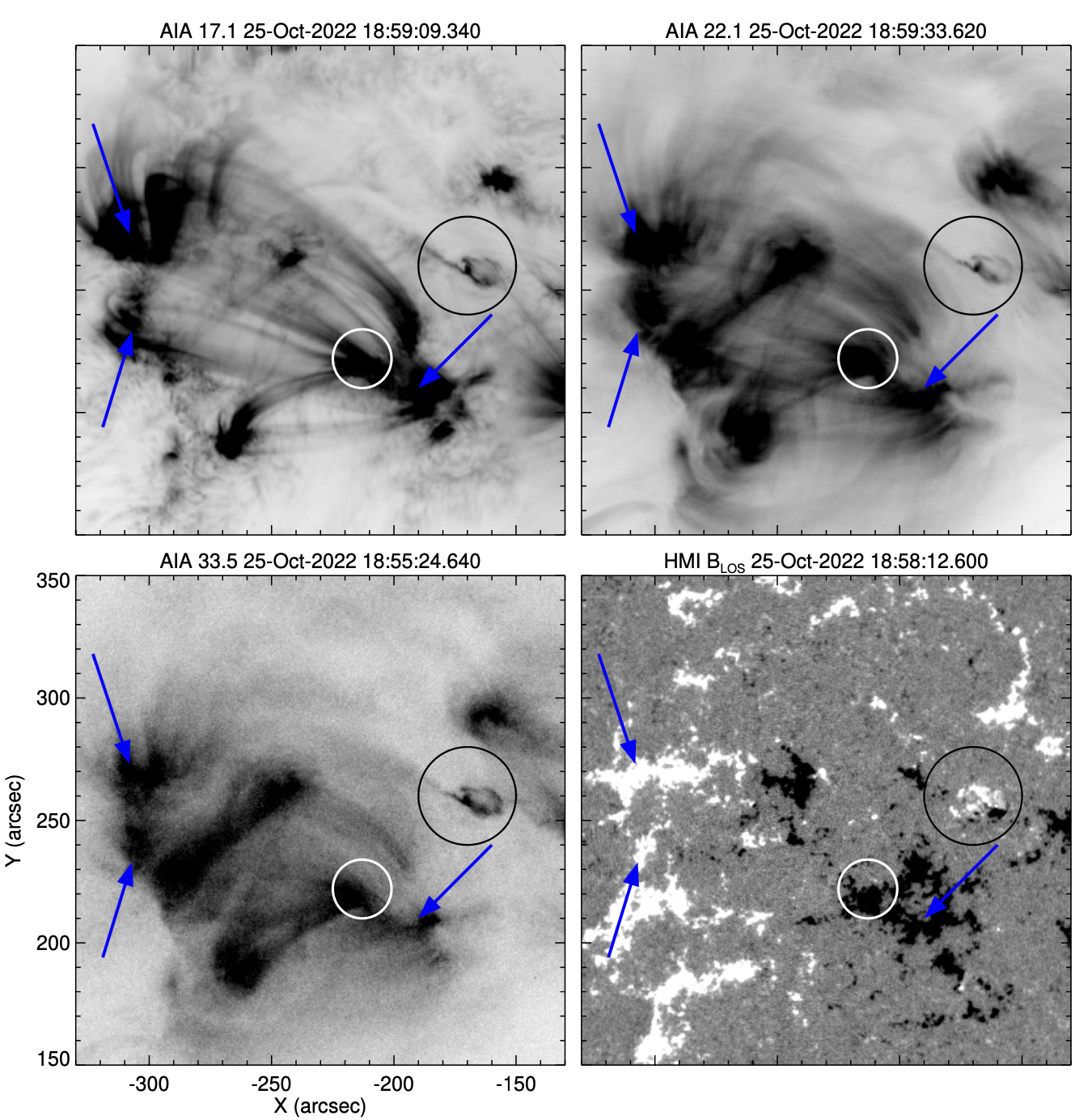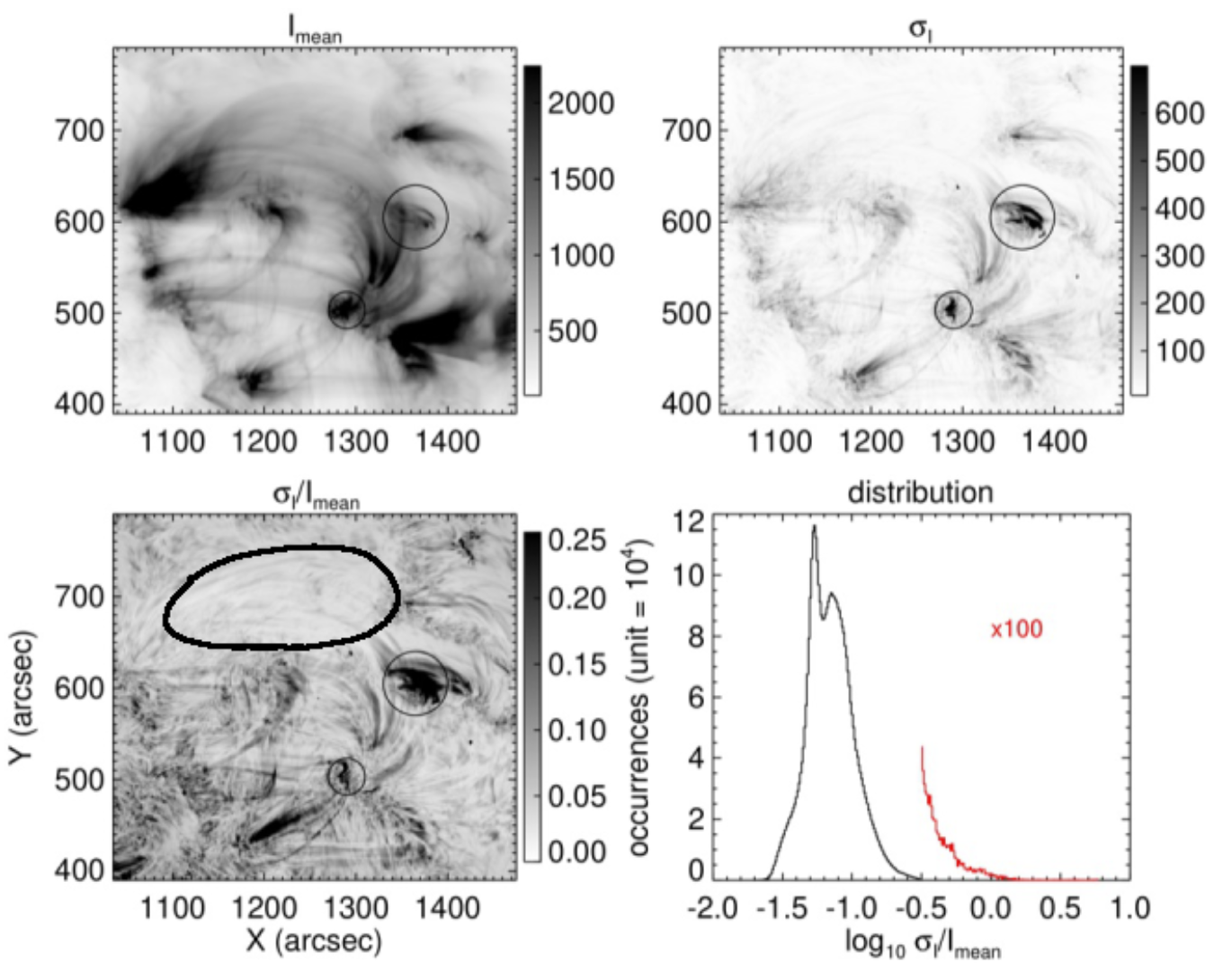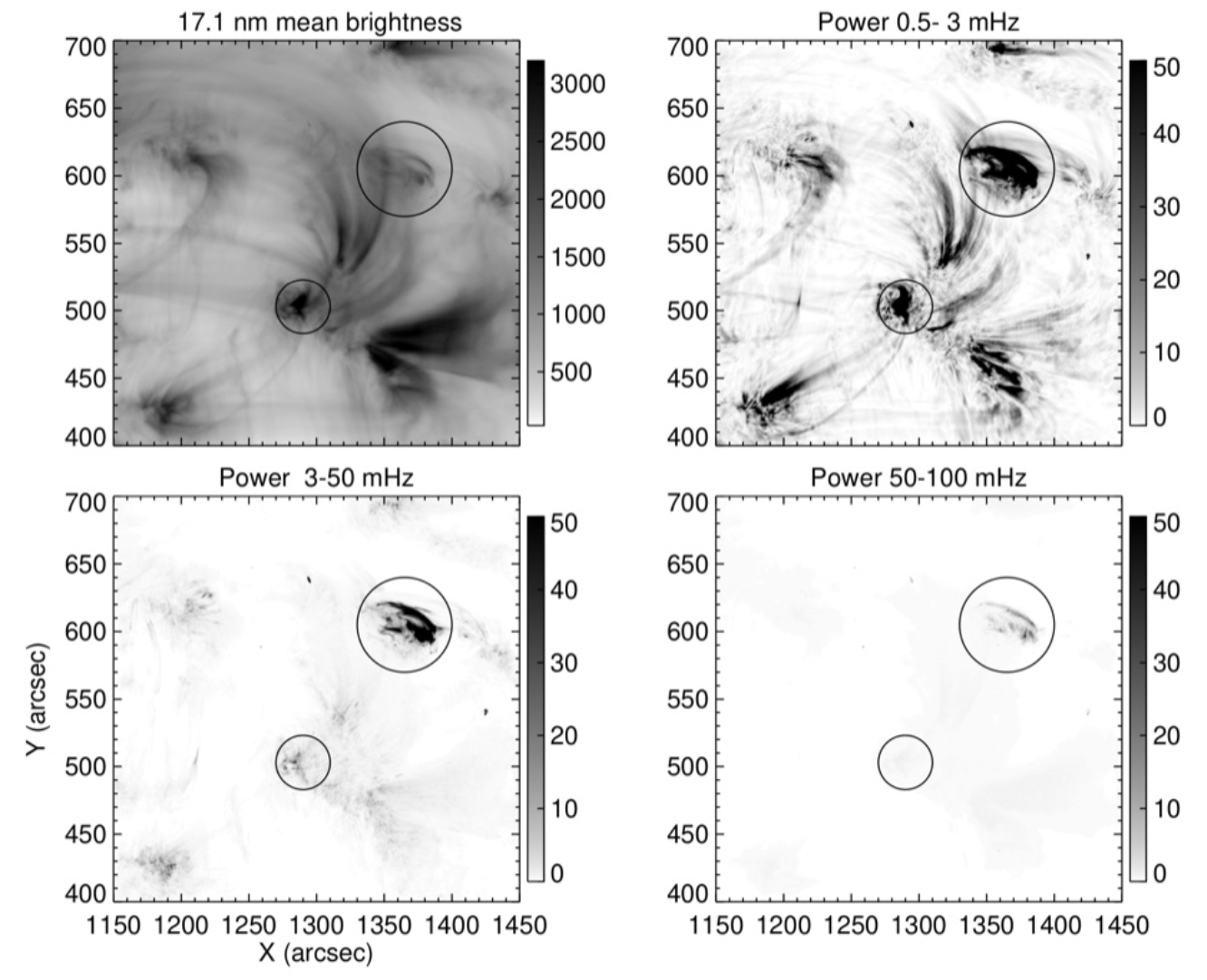Science nugget: EUI data reveal a "steady" mode of coronal heating - Solar Orbiter
EUI data reveal a “steady” mode of coronal heating
(Solar Orbiter nugget #22 by P. G. Judge1)
Coronal heating
In recent years, a consensus seems to have arisen that coronal heating is a dynamic process. For example, in [1], we read: “coronal heating is intrinsically non-steady”. This point is not contested here, for it is well known that the energy input must be variable, being driven by granulation, emerging magnetic flux and additional dynamics associated with plasma in the intervening chromosphere. Thus, correlations between observed features in the photosphere, chromosphere, transition region and corona have been explored in the quest to identify cause and effect, and heating mechanisms (see, e.g. [2,3,4]).
Coronal observations sample the corona on scales above 250 km. However, scales of irreversible heating may approach kinetic scales approaching the ion skin depth (of order 10 m, [5]). In the absence of strong viscous damping by ion-ion collisions, modern theories of MHD turbulence imply that a cascade of energy, or the development of small scales by waves in inhomogeneous media, may continue down to kinetic scales [6].
A question then arises: Should we expect processes responsible for coronal heating to be directly observable? This question is rarely acknowledged in observational studies of coronal heating. The scales accessible to remote sensing of the corona lie between ∼ 100 Mm (the size of an active region), and ≈ 250 km. This range spans between 2 and 3 decades. In contrast, the unresolved range (250 km down to 10 m) spans over 4 decades. Most models of coronal heating involve the development of small scales within current sheets and internal surface waves [e.g. 7,8,9]. The sobering conclusion is that, if the dynamics responsible for heating lie in the range below 250 km, then all previous correlative studies would fail to inform on heating mechanisms. Note that these comments apply only to heating, not to coronal dynamics leading to flares, CMEs and space weather.
In the present nugget, a sequence of 360 EUI images is scrutinized, to examine proposals that coronal heating occurs in quanta, i.e. in bursts of energy. The straightforward analysis has new implications owing to the high quality of EUI data.
EUI data
On October 22 2022, the EUI instrument acquired 360 images of the solar corona at 17.4 nm, every 5 seconds. Although these data are of comparable resolution to those obtained by the HiC rocket payload [10], the image sequence extended over 30 minutes, far longer than the few minutes available during a rocket flight. Therefore, the EUI data are unique in terms of their high cadence, small pixel size, large field of view, and stability. EUI images the plasma at wavelengths centered near 17.4 nm, sampling radiation mostly of ions of Fe8+ and Fe9+ . Figure 1 shows the field-of-view of the EUI dataset discussed here as sampled by the Solar Dynamics Observatory satellite. Three panels plot the plasma at 17. 1 nm, 21.1 nm, and 33.5 nm as measured by the Atmospheric Imaging Assembly, whilst the bottom right panel plots the line-of-sight magnetic field as sampled by the Helioseismic and Magnetic Imager. The 21.1 nm and 33.5 nm images are dominated by Fe13+ and Fe15+ respectively, while the 17.1 nm data are representative of hot plasma radiating in ions from Fe8+ to Fe13+.

Figure 1: Four images observed from SDO, including the 13.1, 17.1 nm and 33.5 nm AIA images which sample plasmas near 0.5, 1 and 2-3 MK respectively, outside of flares. Arrows point to loop footpoints. The encircled region in black shows a magnetic bipole emerging actively during the EUI observations.
In February 2023, F. Auchere shared a movie of the EUI dataset discussed here (as well as other data [11]) to a group at ISSI in Bern, Switzerland. An example of such a movie is included at the end of this nugget. The most striking feature, to the writer who was visiting ISSI, was the apparent steadiness of large areas of coronal loops, away from loop footpoints. Such a lack of variation can pass unnoticed as researchers seek “events”, times and places where the images vary dramatically, to try to study cause and effect within the hydromagnetic environment. To explore possible implications of these unique EUI data, images were co-aligned to sub-pixel accuracy, and then power spectra for each pixel we calculated using the Fourier transform approach advocated by [12], as a function of frequency. The mean intensity and variance of the EUI dataset are shown in Figure 2, whilst the integrals of the power spectra are shown in Figure 3.

Figure 2: The mean of the timeseries is shown (top left) with the rms variations (top right), and their ratio (bottom left). The hand-drawn oval contains regions of reduced σI/Imean. The line plot shows the distribution of log10 σI/Imean. Larger variances are magnified by a factor of 100 in the red line.
Two types of behavior were immediately evident. Firstly, regions of emerging flux have power at all frequencies, prominent examples are circled in the figures. Secondly, the long plasma loops have essentially no power above 3 mHz, see the oval hand-drawn area of Figure 2. The variations within such loops have rms/mean values as small as σI/Imean ∼ 0.01, a 1% variation. A third type of behavior involves low-frequency (< 3 mHz) power extending from near these loop footpoints at X = 1330, Y = 550, and X = 1180, Y = 430, in the upper right panel of Figure 3. This behavior is absent in the other footpoint region near X = 1060, Y = 630.

Figure 3: Frequency-delimited variances (integrated power spectra) of the EUI timeseries.
Parker ([8], section II) noted that nanoflares would yield fluctuations of about 40%, in agreement with transition region lines reported by [13]. However, the relationship between transition region and coronal plasmas still remains unclear after many years [14,15]. The small EUI variations more directly limit acceptable parameters of impulsive coronal heating.
Nanoflares
Based upon full-Sun observations of hard X-rays, [8] proposed that the solar corona may be heated in bursts, in quanta of energy, called “nanoflares”. Much work has been done since then [16], attempting to find evidence in favor of or against this proposal. As formulated by Parker, nanoflares are expected to release about E = 1024 erg of energy in t = 5 × 104 s. To support the average rate of energy loss from active region loops requires an upward directed power F ≈ 107 erg cm−2 s−1 [17]. The area at the coronal base needed to balance F with the nanoflare energy loss is: A16 = 0.0002 * E24 / (t4.7 * F7). The subscripts indicate the unit in cgs units of each variable: A16 ≡ A/1016 cm2 ≡ 1 Mm2. Hence the area across the loop footpoint heated by each nanoflare is ∼ 0.0002 Mm2. If this area expands by a factor f > 1 as it extends high in the corona, each nanoflare would release its energy into a cross-sectional area 0.0002 * f Mm2 near the loop apex.
On Oct 22 2022, the area subtended by one EUI pixel at the Sun was 148 × 148 km2, or a16 = 0.022. Each such pixel would intercept plasma heated by nnano ∼ 1.2 * sqrt (a16 / A16) ≈ 12 * f−1/2 nanoflares. Over 1800 seconds, we would expect to count 1800*nnano / (5 * 104) ≈ 0.4 / sqrt(f) nanoflares per pixel. A value of f between 1 and 10 seems reasonable. With f = 3 we should see one nanoflare every 4th pixel across the loop. With N such structures along each line of sight (LOS), then we would see N/4 nanoflares in each pixel. Random observed variations characterized by Imean/σI ∼ 50 per pixel, if caused by Nnano nanoflares, would yield sqrt(N / 4) = 50, so that Nnano ∼ 104 nanoflares along each LOS. Viewed another way, if N / 4 ∼ 1, then we would expect to see variations of order for σI/Imean ≈ 0.5 in each EUI pixel.
Lessons learned
The remarkable 1% statistical fluctuations measured with EUI along active region loops seem to require about 104 quanta of energy, if indeed energy is released in quanta. If nanoflares, there would have to be 104 of them along each line of sight. This number would imply brightnesses 104 times higher.
In [18], the argument was turned around to find the quantum of energy release consistent with the observed statistics. The answer turned out to be about E ∼ 1021 erg, i.e. pico-flares. The arguments, comparisons with the literature on nanoflares, and supplemental but critical properties of resolved coronal emission line profiles, are detailed by [18].
The writer drew several lessons in working with this EUI dataset. Sometimes it is the things that the Sun does not do that can add useful information. The apparent “lack of a signal” to some can become the dominant signal for others. One might argue that it is important to study all properties of data - including the fact that something is not changing, to avoid the slippery problem of confirmation bias [19]. The area of coronal heating is rich in ideas [e.g. 1, 20], but is arguably weakly constrained owing to a paucity of information-rich observations [15]. The well-calibrated EUI instrument has offered new simple clues to provide interesting limits on a certain class of models.
The primary result was made possible owing to the small EUI pixels, and the tiny 1–2% rms changes of intensity measured along these loops, and the simple assumption that energy is released in bursts, or quanta, after a build up of free magnetic energy. The elementary nature of this study reminds us, as exemplified in the work of medieval thinkers like Roger Bacon and William of Occam, as well as Galileo, that information rich experiments and observations are the final arbiter in science. Eugene Parker, father of so many ideas in solar plasma physics, anticipated such simple advances decades ago [21, 8].
This study has been published in P. G. Judge, 2023, ApJ, 957, 25, https://doi.org/10.3847/1538-4357/acf83a
Acknowledgements
The author thanks Lucia Kleint and the astronomy department at the University of Bern and the Swiss National Science Foundation (grant No. 216870). Support from the Visiting Scientist program of the International Space Science Institute (ISSI) in Bern made this work possible. This material is based upon work supported by the National Center for Atmospheric Research, which is a major facility sponsored by the National Science Foundation under Cooperative Agreement No. 1852977.
Affiliations
1 High Altitude Observatory, National Center for Atmospheric Research, Boulder CO 80307-3000, USA
References
[1] Ineke De Moortel and Philippa Browning. Recent advances in coronal heating. Philosophical Transactions of the Royal Society of London Series A, 373(2042):20140269–20140269, April 2015.
[2] G. H. Fisher, D. W. Longcope, T. R. Metcalf, and A. A. Pevtsov. Coronal heating in active regions as a function of global magnetic variables. ApJ, 508:885–898, December 1998.
[3] C. H. Mandrini, P. Demoulin, and J. A. Klimchuk. Magnetic field and plasma scaling laws: Their implications for coronal heating models. ApJ, 530:999–1015, 2000.
[4] Markus J. Aschwanden. An Evaluation of Coronal Heating Models for Active Regions Based on Yohkoh, SOHO, and TRACE Observations. ApJ, 560:1035–1044, October 2001.
[5] J. M. Davila. Solar tomography. ApJ, 423:871, March 1994.
[6] Alexander A. Schekochihin. MHD Turbulence: A Biased Review. Journal of Plasma Physics, 88:155880501, October 2022.
[7] J. A. Ionson. The Heating of Coronae. Solar Phys., 100:289, October 1985.
[8] E. N. Parker. Nanoflares and the solar x-ray corona. ApJ, 330:474–479, 1988.
[9] David I. Pontin and Eric R. Priest. Magnetic Reconnection: MHD Theory and Modelling. Living Reviews in Solar Physics, 19:1, December 2022.
[10] L. A. Rachmeler, J. Trujillo Bueno, D. E. McKenzie, R. Ishikawa, F. Auchere, K. Kobayashi, R. Kano, T. J. Okamoto, C. W. Bethge, D. Song, E. Alsina Ballester, L. Belluzzi, T. del Pino Aleman, A. Asen- sio Ramos, M. Yoshida, T. Shimizu, A. Winebarger, A. R. Kobelski, G. D. Vigil, B. de Pontieu, N. Narukage, M. Kubo, T. Sakao, H. Hara, Y. Suematsu, J. Stepan, M. Carlsson, and J. Leenaarts. Quiet Sun Cen- ter to Limb Variation of the Linear Polarization Observed by CLASP2 Across the Mg II H and K Lines. ApJ, 936:67, September 2022.
[11] F. Auchere, E. Soubrie, G. Pelouze, and E ́. Buchlin. Image Enhancement with Wavelet-Optimized Whitening. A&A, 670:A66, February 2023.
[12] J.W. Brault and O.R. White. The analysis and restoration of astronomical data via the fast fourier transform. A & A, 13:169–189, 1971.
[13] J. G. Porter, R. L. Moore, E. J. Reichmann, O. Engvold, and K. L. Harvey. Microflares in the solar magnetic network. ApJ, 323:380, December 1987.
[14] Philip Judge, Lucia Kleint, Roberto Casini, Alfred de Wijn, Thomas Schad, and A. Tritschler. Magnetic fields and plasma heating in the Sun’s atmosphere. ApJ submitted, September 2023, September 2023.
[15] P. G. Judge and J. A. Ionson. The Problem of Coronal Heating. A Rosetta Stone for Electrodynamic Coupling in Cosmic Plasma. Springer, in press, 2023.
[16] S. A. Bogachev, A. S. Ulyanov, A. S. Kirichenko, I. P. Loboda, and A. A. Reva. Microflares and Nanoflares in the Solar Corona. Physics Uspekhi, 63:783–800, November 2020.
[17] G. L. Withbroe and R. W. Noyes. Mass and energy flow in the solar chromosphere and corona. Ann. Rev. Astr. Astrophys., 15:363–387, January 1977.
[18] Philip G. Judge. Steadiness of coronal heating. ApJ, 957:25, 2023.
[19] R. Barker Bausell. The Problem with Science. The Reproducibility Crisis and What to Do About It. Oxford University Press, 2021.
[20] Nicholeen M. Viall, Ineke De Moortel, Cooper Downs, James A. Klimchuk, Susanna Parenti, and Fabio Reale. The heating of the solar corona. In Nour E. Raouafi and Angelos Vourlidas, editors, Solar Physics and Solar Wind, volume 1, page 35, May 2021.
[21] E. N. Parker. Magnetic neutral sheets in evolving fields. ii - formation of the solar corona. ApJ, 264:642, January 1983.
Movie 1. The evolution of the EUI field-of-view during part of the time-period discussed here. Credit: F. Auchere and collaborators.
- Removed a total of (3) style margin:0;
Nuggets archive
2025
09/04/2025: Bursty acceleration and 3D trajectories of electrons in a solar flare
02/04/2025: Picoflare jets in the coronal holes and their link to the solar wind
19/03/2025: Radial dependence of solar energetic particle peak fluxes and fluences
12/03/2025: Analysis of solar eruptions deflecting in the low corona
05/03/2025: Propagation of particles inside a magnetic cloud: Solar Orbiter insights
19/02/2025: Rotation motions and signatures of the Alfvén waves in a fan-spine topology
12/02/2025: 'Sun'day everyday: 2 years of Solar Orbiter science nuggets that shed light on some of our star's mysteries
22/01/2025: Velocity field in the solar granulation from two-vantage points
15/01/2025: First joint X-ray solar microflare observations with NuSTAR and Solar Orbiter/STIX
2024
18/12/2024: Shocks in tandem : Solar Orbiter observes a fully formed forward-reverse shock pair in the inner heliosphere
11/12/2024: High-energy insights from an escaping coronal mass ejection
04/12/2024: Investigation of Venus plasma tail using the Solar Orbiter, Parker Solar Probe and Bepi Colombo flybys
27/11/2024: Testing the Flux Expansion Factor – Solar Wind Speed Relation with Solar Orbiter data
20/11/2024:The role of small scale EUV brightenings in the quiet Sun coronal heating
13/11/2024: Improved Insights from the Suprathermal Ion Spectrograph on Solar Orbiter
30/10/2024: Temporally resolved Type III solar radio bursts in the frequency range 3-13 MHz
23/10/2024: Resolving proton and alpha beams for improved understanding of plasma kinetics: SWA-PAS observations
25/09/2024: All microflares that accelerate electrons to high-energies are rooted in sunspots
25/09/2024: Connecting Solar Orbiter and L1 measurements of mesoscale solar wind structures to their coronal source using the Adapt-WSA model
18/09/2024: Modelling the global structure of a coronal mass ejection observed by Solar Orbiter and Parker Solar Probe
28/08/2024: Coordinated observations with the Swedish 1m Solar Telescope and Solar Orbiter
21/08/2024: Multi-source connectivity drives heliospheric solar wind variability
14/08/2024: Composition Mosaics from March 2022
19/06/2024: Coordinated Coronal and Heliospheric Observations During the 2024 Total Solar Eclipse
22/05/2024: Real time space weather prediction with Solar Orbiter
15/05/2024: Hard X ray and microwave pulsations: a signature of the flare energy release process
01/02/2024: Relativistic electrons accelerated by an interplanetary shock wave
11/01/2024: Modelling Two Consecutive Energetic Storm Particle Events observed by Solar Orbiter
2023
14/12/2023: Understanding STIX hard X-ray source motions using field extrapolations
16/11/2023: EUI data reveal a "steady" mode of coronal heating
09/11/2023: A new solution to the ambiguity problem
02/11/2023: Solar Orbiter and Parker Solar Probe jointly take a step forward in understanding coronal heating
25/10/2023: Observations of mini coronal dimmings caused by small-scale eruptions in the quiet Sun
18/10/2023: Fleeting small-scale surface magnetic fields build the quiet-Sun corona
27/09/2023: Solar Orbiter reveals non-field-aligned solar wind proton beams and its role in wave growth activities
20/09/2023: Polarisation of decayless kink oscillations of solar coronal loops
23/08/2023: A sharp EUI and SPICE look into the EUV variability and fine-scale structure associated with coronal rain
02/08/2023: Solar Flare Hard Xrays from the anchor points of an eruptive filament
28/06/2023: 3He-rich solar energetic particle events observed close to the Sun on Solar Orbiter
14/06/2023: Observational Evidence of S-web Source of Slow Solar Wind
31/05/2023: An interesting interplanetary shock
24/05/2023: High-resolution imaging of coronal mass ejections from SoloHI
17/05/2023: Direct assessment of far-side helioseismology using SO/PHI magnetograms
10/05/2023: Measuring the nascent solar wind outflow velocities via the doppler dimming technique
26/04/2023: Imaging and spectroscopic observations of EUV brightenings using SPICE and EUI on board Solar Orbiter
19/04/2023: Hot X-ray onset observations in solar flares with Solar Orbiter/STIX
12/04/2023: Multi-scale structure and composition of ICME prominence material from the Solar Wind Analyser suite
22/03/2023: Langmuir waves associated with magnetic holes in the solar wind
15/03/2023: Radial dependence of the peak intensity of solar energetic electron events in the inner heliosphere
08/03/2023: New insights about EUV brightenings in the quiet sun corona from the Extreme Ultraviolet Imager








































 Sign in
Sign in
 Science & Technology
Science & Technology